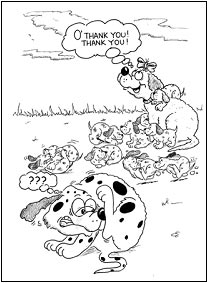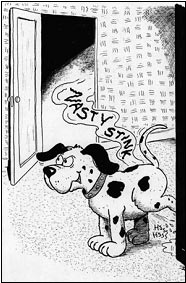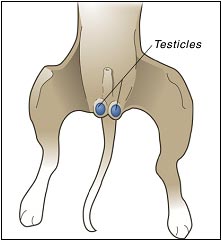Most
male animals (stallions, bulls,
boars, rams, and tomcats) that
are kept for companionship,
work, or food production are
neutered (castrated) unless
they are intended to be used
as breeding stock. This is a
common practice to prevent unacceptable
sexual behavior, reduce aggressiveness,
and prevent accidental or indiscriminate
breeding. However, many dog
owners choose not to neuter
their male dogs, despite the
benefits.
How
does neutering affect behavior?
The
only behaviors that will be
affected by castration are those
that are under the influence
of male hormones (see below).
A dog's temperament, training,
personality and ability to do
"work" are a result
of genetics and upbringing,
not its male hormones. Castration
does not "calm"
an excitable dog, and unless
a castrated male dog is overfed
or under-exercised, there is
no reason for it to become fat
and lazy.
What
is castration?
Castration
or neutering of male dogs is
surgical removal of the testicles
(orchidectomy). The procedure
involves general anesthesia.
An incision is made just in
front of the scrotal sac and
both testicles, leaving the
sac intact. Vasectomies are
not performed since it is both
sterilization and removal of
the male hormones that provide
the behavioral and medical benefits.
Which
of my dogs' behavior problems
can be expected to improve following
castration?
As
mentioned, only those behaviors
that are "driven"
by male hormones, can be reduced
or eliminated by castration.
Although the hormones are gone
from the system almost immediately
following castration, male behaviors
may diminish quickly over a
few days or gradually over a
few months.
Undesirable
sexual behavior: Attraction
to female dogs, roaming, mounting,
and masturbation can be reduced
or eliminated by castration.
(a)
Case studies show that for roaming
there was moderate improvement
in 70% of dogs with marked improvement
in 40%. For mounting there was
moderate improvement in 70%
of dogs with marked improvement
in 25%.
(b)
In one study, castration led
to reduced aggression toward
other dogs in the house in 1/3
of cases, towards people in
the family in 30% of cases,
towards unfamiliar dogs in 20%
of cases and towards unfamiliar
people in 10% of cases.
Urine
Marking: Most adult
male dogs lift their legs while
urinating. Instead of emptying
their bladders completely, most
male dogs retain some urine
to deposit on other vertical
objects that they pass. Some
males have such a strong desire
to mark that they also mark
indoors. Castration reduces
marking in 80% of dogs with
a marked improvement in 40%.
 Aggression:
Every aggressive dog should
be castrated. At the very least
this will prevent reproduction
and passing on of any genetic
traits for aggression. Castration
may also reduce or eliminate
some forms of aggression (i.e.
those that are influenced by
male hormones). Aggression:
Every aggressive dog should
be castrated. At the very least
this will prevent reproduction
and passing on of any genetic
traits for aggression. Castration
may also reduce or eliminate
some forms of aggression (i.e.
those that are influenced by
male hormones).
Are
there any additional benefits
to castration?
Medical
benefits: Castration
eliminates the possibility of
testicular cancer and greatly
reduces the chance of prostate
disease, two extremely common
and serious problems of older
male dogs. Most older dogs will
develop prostate disease or
testicular tumors if they survive
to an old enough age. Castration
can also reduce the risk of
perianal tumors and perineal
hernias.
Population
control: Perhaps the
most important issue is that
millions of dogs are destroyed
annually at animal shelters
across the United States and
Canada. Neutering males is as
important as spaying females
when it comes to population
control.
Are
there any risks?
Nowadays,
with the broad selection of
anesthetic agents and state
of the art monitoring, it is
extremely rare for there to
be anesthetic or surgical complications
during a canine castration.
Most
young and healthy animals recover
without incident. Often, the
biggest concern is not the surgery
and anesthesia, but the recovery,
since we need to ensure that
the dog does not lick excessively
at its incision line until it
is fully healed. Constant monitoring,
bitter tasting creams, or a
protective collar, known as
an Elizabethan collar, will
be required if excessive licking
is observed following castration.
When
castration is being considered
for an older dog, the benefits
must be weighed against any
risks associated with anesthetic
and surgery. Since castration
surgery is seldom associated
with any complications, it is
the anesthetic that is the primary
concern. If castration is being
considered as a separate procedure
for a medical reason (prostatic
enlargement, testicular tumors,
perianal tumors), then there
is a significant benefit to
the dog's health, comfort
and perhaps longevity, in having
the castration performed. If
the dog is exhibiting any undesirable
behaviors that might be improved
by castration (roaming, masturbation,
mounting, interdog aggression,
excessive sexual interest or
marking), there may also be
a significant benefit to be
gained from castration. Although
not infallible, a physical examination,
a series of blood and urine
tests and any additional screening
that your veterinarian may feel
is warranted for your dog (e.g.
EKG, chest radiographs), can
help to determine if your pet
has any significant anesthetic
risks. These tests can also
help the veterinarian determine
which anesthetic protocol would
be safest for your pet. Since
many older pets require anesthesia
for other procedures (e.g. growth
removal, preventive dentistry),
the benefits can often be further
increased, and the number of
anesthetic procedures reduced
by performing the castration
along with the other procedure.
What
age is best for preventive castration?
A
number of studies have shown
that castration is just as effective
at reducing male associated
behavior problems as it is at
preventing them. This means
that whether the pet is castrated
post-pubertally (e.g. 1 year
or older) or pre-pubertally
(e.g. 2 months of age) the behavioral
effects are likely to be the
same. There is, however, anecdotal
evidence that dogs that are
sexually experienced are more
likely to retain their sexual
habits after castration, compared
to those dogs that have had
little or no sexual experience
prior to castration. It has
been advocated recently that
castration be performed at as
young an age as is practical,
to ensure that it is done before
the pet has a chance to breed.
This is most important in animal
shelters since it allows them
to ensure that every dog adopted
has already been castrated.
To date, studies have shown
that castration is safe, and
has no long-term effects on
health or behavior, regardless
of the age that it is performed.
Many shelters and some veterinary
clinics begin neutering as young
as two months of age. They report
that the surgery is often shorter
and that recovery is quicker
and with less post-operative
discomfort for these younger
animals. Once dogs are adopted
into their new homes, most veterinarians
recommend waiting until all
vaccinations are complete before
admitting the pet into the hospital
for surgery. However, if general
anesthesia were needed prior
to the vaccinations being completed
for any other reason (e.g. suturing
a cut, removing quills) this
would be an excellent time to
consider castration. In summary,
there seems to be no behavioral
or medical benefit to waiting
until a dog is "mature"
to perform a castration.
My
dog has retained testicles -
what does this mean?
During
fetal development or shortly
after birth, the testicles will
descend into the scrotal sac.
In some dogs, likely due to
a genetic predisposition, the
testicles may not descend into
the scrotal sac. These dogs
are known as either unilateral
(one testicle) or bilateral
(both testicles) cryptorchids.
The testicle may be retained
in the abdomen or anywhere between
the abdominal cavity and the
external sac. Retained testicles
do not usually produce sperm,
but they will produce hormones,
which can lead to any of the
behavioral changes or medical
problems previously discussed.
In fact, some studies have shown
that retained testicles may
be more prone to developing
cancer. At the very least, it
would be extremely difficult
to determine if a testicle,
which is located in the abdomen,
begins to develop cancer, since
it cannot be palpated. All dogs
with retained testicles should
be neutered (and both testicles
removed) for medical and behavioral
reasons, and to ensure that
this genetic abnormality is
not perpetuated.
This
client information sheet is
based on material written by
Debra Horwitz, DVM, DACVB and
Gary Landsberg, DVM, DACVB.
© Copyright 2002 Lifelearn
Inc. Used with permission under
license. March 11, 2004. |